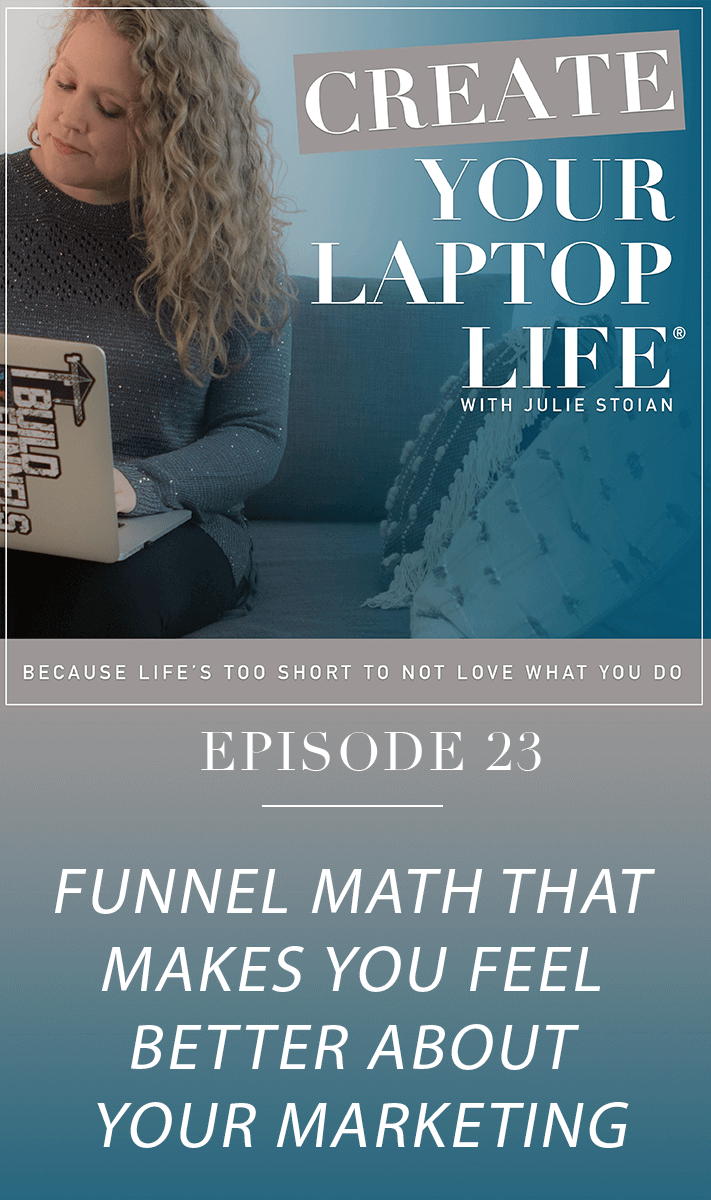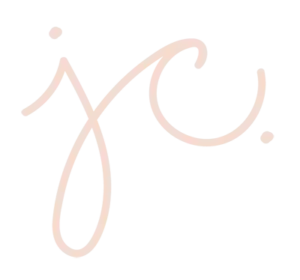In this episode, I go into “funnel math” – and explain why understanding funnel math is the difference between winning and quitting.
Subscribe On:
Full Transcript:
Hey everyone, hope you’re doing awesome. Today, I want to take you through a little bit of a math problem. Nobody run away screaming from the room. I know math isn’t always our favorite subject, but I just came back from my Digital Insiders Mastermind and one of the biggest aha moments that everybody had, happened after I showed them this particular math. So if you are listening to this podcast and you’re at the gym or you’re driving, I would listen to it a second time with a pad and a paper and a pen because I want to show you how math can make you feel awesome.
So, Brie, she is in my mastermind and she built a funnel sales funnel. A webinar funnel that leads to her program that she’s selling called Cashflow Day. It’s about a $300 program and she’s been struggling with feeling like is it working, is it not working? And it’s funny because I keep telling her it’s working, but for some reason, she didn’t believe me.
Sometimes when you’re first running ads, your ad costs are higher. You’re not very good at ads yet. So then it can feel like you’re not making any money because you’re spending all that money in the ads. But I wanted to kind of calibrate expectations.
So I did this entire exercise at the mastermind and showed everybody how to adjust their expectations and how to know if a funnel is actually working. So if you are sitting down with a pad and paper, I want you to draw three boxes in a row, okay? So basically we’re going to draw out a funnel together.
Now, the first page in the funnel is going to be the squeeze page. That’s going to be the page where you give away something for free. So in that first box, just write “FREE” and then the box right next to it, put one box to the right. That’s going to be the offer. That’s the thing that you sell after they opt-in right? You give them something for free and then you’re like, ah, awesome. Okay, here is a $27 course. So in that second box, write $27. Now a lot of people who work with me, or if you know Russell and you’re in the funnel world, you know that when you get somebody to say yes to something like a workshop or a course for $27, you’re leaving money on the table.
If you don’t add what’s called an order bump. And that’s a little thing at the bottom where if you check off, it adds something extra to their order. So at the bottom of your little box, the word order bump, and then put a price of $37 because maybe you have something else you can sell them. That’s a simple order bump. Then the third box, the next box over to the right is going to be your OTO. This is your one-time offer. This is an upsell. So they’ve said yes to your $27 workshop. Maybe they clicked the box to get the order bump, maybe they didn’t. And now they’re being shown a page that says, wait, your credit card is being processed. But before you go, I have a one-time offer. Click YES or NO to buy. So let’s pretend that you have an OTO that’s a course that’s $77.
So now on your paper, you should have a squeeze page that says FREE, a box in the middle that says $27 with a little order bump at the bottom of the box that says $37. And then you should have the third box, which is the OTO, and that should say $77.
Now, here’s where we do the math. You want to figure out if your funnel is going to be profitable, you need to understand what is “normal.” And I put normal in quotes because for every industry it’s a little bit different. And eventually ,you’re going to have benchmarks for yourself. You’re going to know what your normal is and then you can compare yourself against yourself. But when you’re just getting started, you might not have any stats. So I’m going to give them to you. So in the first box, I’m going to tell you that it’s pretty normal to have somewhere between a 20% to 30% optin rate.
So just write 20% to 30% in that first little box. Okay? That’s normal. On the middle box, the offer box where you’re selling that $27 course or workshop, I want you to write 1% to 5% because that’s normal. It is normal for 1% to 5% of people who see this page to buy it. Not 10 percent, not 20, not 30, not 50, right? We think, Oh, if one hundred people see this offer, we’re going to get 10 sales. No, you’re probably not.
So, I’m trying to calibrate your expectations with this math problem. Now, if you go to the bottom of that box, for the order bump, believe it or not, has a higher conversion rate than the actual product. And why? Psychologically when you get somebody to say yes, it’s easier to get them to say yes again.
So they’ve already put their credit card information for the $27 workshop. Now all they have to do to say yes to that order bump, that $37 order bump is just check a little box and now they’ve said yes. So it’s actually a lot easier to get money from an order bump. So put 40 percent. Now that’s a little high. I would say, if you’re just starting out or you don’t have a good order bump, probably it’s closer to 20 to 30 percent. So if you want to be conservative you can be conservative. So put 20 to 40 percent right there next to the order bump, okay? And then the last box, your OTO box where you have a $77 offer, you can say safely say 3% to 10% of people will buy the OTO, again, still higher than the initial offer.
That initial $27 offer in that middle box is the hardest thing. And once you get them to say yes, you get more and more people.
So all your percentages. So now you should have your three boxes that make up your sales funnel. You should have the different prices and you should have the percentage points. So now this is where the math comes in.
Let’s say you get 5,000 people to see your squeeze page, to see your free offer. Okay? 5,000 people. If we’re going with a 30 percent opt in rate, okay? Because it’s between 20 and 30, let’s just be optimistic. Thirty percent of people opt in. How many people are actually going to get to that second box? 1,500, right? So 1,500 people are actually going to see your offer for that $27 product. Now we said one to five percent will buy.
So if we say three and a half to four. Again, let’s be optimistic here. That would be about 50 sales. 50 sales of your $27 offer works out to be $1,350 ish. Okay.
So you’ve just made $1,350 because 50 people bought your offer. And why did 50 people buy? Because you had a four percent buy rate on the 1500 who saw it and why did you only have 1500?
Because at a 5,000 people that landed on the squeeze page, you had a 30 percent opt in rate. So we’ve made about $1,350. But now we have to remember there’s the order bump and there’s the OTO. So if you look at the order bump and you assume that 40 percent of people who bought. So 40 percent of those 50 people bought that $37 offer that actually adds an additional $700 in sales. I think it’s like $740.
And lastly, of those 50 people who bought, let’s say seven percent of those people actually take the OTO, that’s another $300 in sales. So all together, if you take $1350 right? Which was how many people bought the original plus the additional $700 from the order bump plus the additional $300 from the OTO you’ve actually now made $2,350.
Now the last question is, that means the funnel is working, right? Those that you’re basing it on percentages. Now, the reason why people don’t think the funnel is working is because when they run ads, how much is it going to cost them to get that sale?
Well, we started with what number? We started with 5,000 clicks, right? 5,000 views. So this is where Facebook Ad math works super easy. So we know that if you can get your funnel to convert like that, we need to get 5,000 people onto the squeeze page and you’ve made $2,300.
Okay? So if Facebook is charging us .50 cents a click over to that squeeze page, we’re going to have to spend $2,500 to get 5,000 clicks. But we only made $2100. So what’s happening there? People are like, God, the funnel doesn’t work and they get mad. But does the funnel work? Yes, the funnel works. The funnel totally works.
Why? Because we looked at the percentages and we know that those percentages are correct. So the funnel does work. You just aren’t making money because why? Because the cost per click for advertising is too high. So you have one of two choices. You can either try to get the cost per click down on the ad or you can try to raise the conversion rate somewhere on your funnel. But based on the math that we just did, this is a very, very high converting funnel based on the benchmarks, right?
Because we were optimistic today. So you need to try to figure out how to get your cost per click down. Okay. So maybe it’s with content, maybe with social strategy, maybe with better ad targeting. But let’s say you can get it down to thirty cents a click, right? So thirty cents, it’s twenty cents less. That doesn’t seem like that much. But guess what happens now it’s only costing you $1,500 to get those 5,000 views on that page.
And based on our math we’ve made $2150. So if you take $2150 and you subtract the 1500 at cost, you’ve now made $850 in profit. And if I said to you every day you’re going to give me $1,500 and I’m going to give you $2,350 back, would you do it? And the answer should be hell yes. Right? So some buddies like, well I’m not a millionaire in 15 minutes because my sales funnel only made $850 this week and we feel depressed about that.
But it’s because our expectations are completely off about what a funnel actually does in this math problem that we did. If you can get thirty cents a click to get 5,000 clicks to your landing page and then you have all those conversion rates that I just showed you, you are profiting $850 for every $1,500 you put in.
It’s not quite getting doubling your money but almost. And that’s as good as it gets. So if you built one funnel that’s amazing and if you were getting fifty cents a click, you were not positive, you are net negative and you probably felt like a failure.
So my encouragement to you today, and for those of you who are not sales funnel geeks, this may have felt like Greek to you.
But what I want to say to you, number one is this: manage your expectations. It is the best thing you can do for yourself and your clients. Manage your expectations, do the math and figure out if your funnel is really working or not. Because oftentimes your funnel is working. It’s the ad costs that aren’t. And if your funnel isn’t working, then you fix that and then try again. Thanks so much. Appreciate you guys. Talk soon.
If you’re ready to create, grow, and scale your online business, you can go to createyourlaptoplife.com/podcast and get a free plan on how you can get started today.









0 Comments